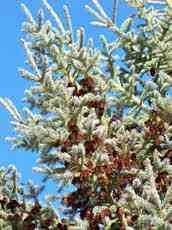Human ecology is the study of the relationship between humans and their natural, social, and built environments. So what does this have to do with trees? In the last several years I’ve run across numerous articles that claim people are more drawn to shopping districts that have trees and landscaping than to those that don’t. Further, they state that people will stay longer and are willing to spend more in the tree-scaped areas.
I also hear that downtown store owners don’t want trees in front of their businesses. They feel any tree that blocks the view of even part of their business translates into fewer customers and sales. Rarely do these articles refer to scientific studies. I decided to check it out.
Kathleen Wolf, University of Washington, seems to be the major investigator and has been researching the role of urban forestry in urban business districts for more than 12 years. Her research was largely funded by the U.S. Forest Service and at least one study involved downtown shopping areas in towns with populations of 10,000 to 20,000. However, she found consistent responses across all town/city sizes investigated. In several studies she compared business peoples’ and consumers’ perceptions regarding trees in revitalizing business districts.
Survey respondents were asked to rate various streetscapes scenes for their visual quality. The scenes showed retail settings with different amounts and arrangements of vegetation. The survey also contained sections of questions about shopper perceptions of places that have or don’t have trees. Lastly, respondents were asked to express what they were willing to pay for goods in three different retail settings, each having a different streetscape character.
In all cases, consumers indicated trees make a different. Comfort ratings for tree-lined sidewalk districts were 80 percent higher than for barren sidewalk districts, and “quality of products ratings” were 30 percent higher. Respondents were asked to give opinions of their behavior within the two types of business environments. They claimed they would stay longer, travel further, and visit more frequently the tree-scaped areas. They also said they’d be willing to pay more for products in this areas.
According to Wolf, “There are differences in how consumers and business people react to the appearance of business settings. First, business ratings of districts without trees are higher than visitor ratings, despite the grim, hard-featured character of the street setting. Then, in response to places with trees, business people consistently rated such places lower than visitors.”
“Are merchants aware that they have less appreciation for trees than consumers, the people they wish to welcome to their shops?” asks Wolf.
A Pacific Northwest Chapter of the International Society of Arboriculture suggests as trees grow up, the canopy can be “limbed up” to raise braches and foliage above signs and store fronts.
Wolf’s original study was published in the Journal of Forestry, December 2005 . Almost all the articles I found relating to trees in business districts are based on this study of perceptions or Wolf’s related work on perceptions.
I’m a proponent of trees in downtown areas for another reason. A paragraph from the Colorado Trees Organization says it best. “Unlike urban areas in the eastern U.S., canopy cover in Colorado decreases along an urban to rural gradient. In other words, since most trees have been planted much of the tree cover is in urban areas as opposed to “natural lands”. Therefore, estimated pollutant uptake rates are higher for residential compared to natural or unmanaged lands. Possible management implications of these estimates are that air pollutant uptake benefits from tree planting may be optimized by planting in areas where air pollutant concentrations are elevated and where relatively high planting densities can be achieved thereby enhancing the health of urban dwellers.”





No comments:
Post a Comment